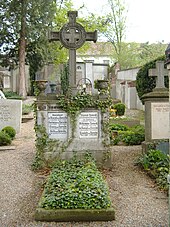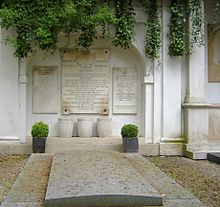Hößlin (noble family)
Hößlin (also Hösslin, Hoeßlin, Hoesslin, Greek Έσσλιν ) is a widespread Bavarian noble family from the Augsburg patriciate .
history
As early as 1420 there were citizens of the same name in the Free Imperial City of Augsburg who appeared as donors and this can be seen as an indication that they were citizens in a certain affluent situation. The gender dividing in many lines, branches and twigs (of which a considerable number in the male line has expired) begins with Gallus Hößlin, citizen of the free imperial city of Lindau. Named was born around 1500 and was married to Anna Balthasarin. The marriage resulted in two sons and a daughter:
"The maiden name of the mother becomes the first name of the son, and from then on all male descendants receive the name Balthasar as the nickname added to the first name"
The goldsmith Bartholomäus Balthasar Hößlin (* July 24, 1659 Lindau, † December 1, 1704 Augsburg) married Maria Jakobine Rad on August 16, 1687 and moved from Lindau to Augsburg in 1688. In 1690 he and his father-in-law Christoph Rad (the elder) (* 1628, † 1710) founded the trading company 'Rad & Hößlin', which can be found soon after at the exhibition centers in Frankfurt and Leipzig and which supplied the European royal courts with silver and goldsmiths in Augsburg; In addition to long-distance trading, he was also active in banking. He became chamber and court jeweler of the Viennese imperial court.


On January 29, 1697, Bartholomäus and later (1707) his brother David were raised to hereditary imperial nobility in Vienna by Emperor Leopold I. Bartholomäus was admitted to the aristocratic Augsburg patriciate on December 20, 1697. Since then, the headquarters of the v. Hösslin Augsburg
From 1710 the company was continued by Christoph (the younger) Rad and Bartholomäus' son Philipp Albrecht Balthasar von Hößlin (* September 2, 1690 Augsburg, † 1750 Augsburg), married to Sabina Barbara von Schnurbein since 1716; Imperial treasurer and court jeweler, army supplier since 1714.
An important client was the Saxon King August the Strong . In 1731 King Friedrich Wilhelm I of Prussia came to Augsburg with Crown Prince Friedrich himself to place a large order for table silver worth 782,361 fl . 1737 with Bartholomäus Falck from Lindau commercial director of Rad & Hößlin in Vienna; Foundation of the company Hößlin & Falck , which existed until around 1750. Philipp Albrecht's descendants also remained connected to trade and banking. Branches u. a. in Venice, Trieste, Vienna, Dresden, Leipzig, Warsaw and St. Petersburg.
In 1810 and 1833 members of the von Hößlin family were enrolled in the aristocratic class in the Kingdom of Bavaria. In the early 19th century, parts of the family emigrated to Italy , during the reign of King Otto I of Bavaria to Greece , to Russia and as farmers to South Africa . In Greece, Julius von Hößlin founded the country's first bank in 1839. His son Konstantin von Hößlin was elected President of the Constituent Assembly and as such had a decisive influence on the Greek constitution, which was passed in 1910.
Today the largest tribes of the family live in Bavaria, Greece and South Africa. As for the genealogy of the Hößlins who emigrated to Russia, whose sons reached high officer ranks in the tsarist army, Hartmut von Hösslin writes:
“It is not known from any of the surviving letters, etc. whether any one of this branch has ever visited Augsburg again. According to the dates of birth of the fourth generation, it can be concluded that they all faced difficult fates as aristocrats in the First World War and, if they survived, in the revolutionary turmoil of 1917 ”
There are several graves of the noble family in the Protestant cemetery in Augsburg .
Traditionally, on Balthasar's name day , January 6th, male descendants (“Vetterles-Treffen”) meet in Augsburg.
coat of arms
From the document of Leopold I: “And to remember such an increase in the nobility, We have graciously confirmed his coat of arms for him Bartholomä Hößlin and we have granted and allowed to use it in the following ways in an improved and increased manner: as because a shield is divided into four parts with a frame, the lower rear and upper front yellow or gold-colored, in each of which a black simple yellow-crowned eagle with raised wings and spreading feet is to be noted inward, in the front below and above the blue or glaze-colored shield part but straight A silver anchor hanging downwards between two golden hexagonal stars: in the middle of the shield is a red heart shield, inside the figure of a naked mermaid in long yellow hair hanging backwards, adorned with a golden crown, also around her body with a golden ribbon with both Hands of the double sea-green tail i In the shape of two buffalo horns, the tail adorned at the beginning and at the end with a golden ornament: On the shield is a freely open aristocratic tournament helmet with an attached jewel and on the left with red and yellow, on the right with blue and white hanging helmet covers and a golden crown above which the figure of a mermaid described in the heart shield can be seen. Then such a noble coat of arms and jewel is painted in this letter written dragonfly-like to Our Imperial on the first page and actually designed with colors. "
Name bearer
- Eduard Friedrich Balthasar von Hößlin (1789–1862)
- Emma von Hoesslin , b. Maier (1884–1968), founder and philanthropist
- Erna von Hoeßlin , b. Liebenthal (also: von Hoesslin; 1889–1946), opera, lied and concert singer
- Franz von Hoeßlin (also: von Hoesslin; 1885–1946), German conductor
- George von Hoeßlin (1851–1923), Kgl. bayer. Painter
- Gustav von Hößlin (1854–1925), personal physician to King Ludwig III. from Bavaria
- Hans von Hößlin (1880–1947), German lieutenant general
- Hans-Jürgen von Hößlin (* 1937), German flotilla admiral, head of the Bavarian Aristocratic Archives (1998–2003)
- Hartmut von Hößlin (1919-2005)
- Heinrich von Hoesslin (1878–1955), human medicine, professor of internal medicine, founder
- Hubert von Hößlin (1882–1968), German major general
- Julius Heinrich Balthasar von Hößlin (1802–1849), banker and merchant in Athens
- Konstantin von Hößlin (1844–1920), first President of the Greek Chamber of Deputies in Athens in 1910
- Moritz von Hößlin (1858–1927), Bavarian lieutenant general
- Ottilie Hermine Louise von Hößlin, married as O. von Voit (1819–1883)
- Richard von Hößlin (1853–1930), Bavarian lieutenant general
- Roland von Hößlin (1915–1944), one of the main players in the German military in the resistance against Adolf Hitler
- Rudolf von Hößlin (1858–1936), Go. Medical adviser, founder and long-time director of the Neuwittelsbach spa facility
- Sebastian Balthasar von Hößlin (1759–1845), city architect for the city of Augsburg from 1806 to 1845
- Walter von Hoesslin (1910–1996), German stage designer, head of the Max Reinhards seminar
- Hermann von Hoesslin (* 1961), German human medicine
literature
- Paul von Stetten: History of the noble families in the free imperial city of Augsburg, Augsburg 1762, p. 330.
- Karl Heinrich Ritter von Lang, Nobility Book of the Kingdom of Baiern, Munich 1815, p. 389.
- Genealogical pocket book of noble houses, 1884 ninth year, Brno, pp. 184–188.
- Gothaisches Genealogisches Taschenbuch der Briefadeligen houses. 1910 Fourth year, Gotha: Justus Perthes pp. 314–318.
- Gothaisches Genealogisches Taschenbuch der Briefadeligen houses. 1912 Sixth year, Gotha: Justus Perthes pp. 443–448.
- Gothaisches Genealogisches Taschenbuch der Briefadeligen houses. 1914 Eighth year, Gotha: Justus Perthes pp. 438–443.
- Gothaisches Genealogisches Taschenbuch der Briefadeligen houses. 1916 Tenth year, Gotha: Justus Perthes p. 418–423.
- Gothaisches Genealogisches Taschenbuch der Briefadeligen houses. 1918 Twelfth year, Gotha: Justus Perthes pp. 392–398.
- Association of the Nobility in Bavaria V. (Hrsg.): Genealogical manual of the aristocracy enrolled in Bavaria, Volume I, Neustadt an der Aisch 1950.
- Association of the Nobility in Bavaria V. (Hrsg.): Genealogical handbook of the nobility enrolled in Bavaria, Volume III, Neustadt an der Aisch 1952, pp. 337–355.
- Association of the Nobility in Bavaria V. (Hrsg.): Genealogical manual of the aristocracy enrolled in Bavaria, Volume XI, Neustadt an der Aisch 1975, pp. 567-596.
- Association of the Nobility in Bavaria V. (Hrsg.): Genealogical handbook of the aristocracy enrolled in Bavaria, Volume XV, Neustadt an der Aisch 1984, pp. 641–670.
- Association of the Nobility in Bavaria V. (Ed.): Genealogical manual of the aristocracy enrolled in Bavaria, Volume XIX, Neustadt an der Aisch 1992, pp. 764–795.
- Association of the Nobility in Bavaria V. (Hrsg.): Genealogical manual of the aristocracy enrolled in Bavaria, Volume XXIII, Neustadt an der Aisch 2000, pp. 760–793.
- Association of the Nobility in Bavaria V. (Hrsg.): Genealogical manual of the aristocracy enrolled in Bavaria, Volume XXVII, Wissenschaftlicher Kommissionsverlag Stegaurach 2008, pp. 833–869.
- Association of the Nobility in Bavaria V. (Ed.): Genealogical handbook of the nobility enrolled in Bavaria, Volume XXXI, Wissenschaftlicher Kommissionsverlag Stegaurach 2016, pp. 807-833.
- Maximilian Gritzner: Status surveys and graces of German sovereigns during the last three centuries, I. Volume from Anhalt to Bavaria
- The royal Bavarian nobility register (1809–1879), pp. 305, 449, 469.
- Karl Friedrich von Frank, Status surveys and acts of grace for the German Empire and the Austrian Hereditary Lands up to 1806, Volume 2 F – J, 1970, Senftenegg Castle, p. 215.
- German Aristocratic Archives e. V. (Ed.): Adelslexikon, Vol. V Has-I, Limburg an der Lahn 1984, pp. 263-264.
- Dr. Anton Mayr: The great Augsburg fortunes from 1618 to 1717, self-published by the city of Augsburg in 1931, pp. 61–68.
- Günther Grünsteudel / Dr. Martha Schad in: Augsburger Stadtlexikon, Wißner, http://www.stadtlexikon-augsburg.de/index.php?id=119 .
- Sylvia Rathke-Köhl: History of the Augsburg goldsmith's trade from the end of the 17th to the end of the 18th century, Swabian historical sources and research volume 6, 1964.
- Dr. Hans von Hoesslin: VON HÖSSLIN - A FORGOTTEN AUGSBURG TRADING COMPANY, Augsburger Blätter, Volume 7, Issue 4, pp. 146–153.
- Hartmut von Hösslin: Hösslin. Data from 5 centuries . Wißner, Augsburg 1997, ISBN 3-89639-087-2 .
Individual evidence
- ↑ Hösslin 1997, p. 6.
- ↑ Hösslin 1997, p. 6.
- ↑ Hösslin 1997, p. 24.
- ↑ like a dragonfly = "if, as usual, you write on a folio sheet and leave only a small space on one side," according to Theodor Heinsius: Preschool of Speech and Speech Art. 3. Edition. Duncker & Humblot, Berlin 1821, p. 288.
- ^ Hermann von Hoesslin biography
swell
- Genealogical private archive v. Hoesslin



